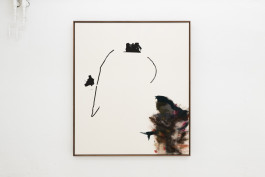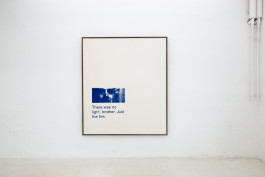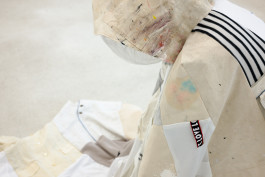Malte Zenses
Im Kugelblitz (Teil 2)
04.02.23–28.02.2023
Installation view













The beauty in decay
Malte Zenses, born in 1987, lives and works in Berlin. Attracted by the aesthetics of subcultures and the zines and symbols of the punk scene, he began to engage in art.
Zenses' artistic practice includes painting, drawing and sculpture as well as music and integrates fragments from everyday life. With a cross-media approach, his various works enter into a dialogue and offer a critical reflection of the zeitgeist. Letters, signs and symbols are part of a vocabulary that marks a realm beyond the visible and alludes to a sense of disillusionment. It is a disillusionment that results from the realization that the collapse of the world is a man-made consequence. Underlying this preoccupation is also an ambivalent fascination with a turning point in time in which the terrible and the radiant coexist. This ambivalence is profoundly reflected in Zenses' works, which can be read in opposite directions. The paintings offer appealing compositions and at the same time the possibility to read in them the tragedy of the subject Zenses deals with in his work. He plays with a certain beauty in the fall of the world and with a romanticism in absolute tyranny.
Textiles play a crucial role in Zenses' work, serving as painting ground and sculptural material. The use of second-hand clothing raises questions about former owners and references social constructions such as gender and class. In Zenses' sculpture, these significant pieces of clothing form a kind of post-apocalyptic cloak, while a sound installation of composite snippets of conversation questioning the world order supports the impression of a surrendering moment and invites the viewer to question their own view of the world and existing structures.
– Amira Hartmann

Malte Zenses
Im Kugelblitz (Teil 2)
04.02.23–28.02.2023
Installation view












The beauty in decay
Malte Zenses, born in 1987, lives and works in Berlin. Attracted by the aesthetics of subcultures and the zines and symbols of the punk scene, he began to engage in art.
Zenses' artistic practice includes painting, drawing and sculpture as well as music and integrates fragments from everyday life. With a cross-media approach, his various works enter into a dialogue and offer a critical reflection of the zeitgeist. Letters, signs and symbols are part of a vocabulary that marks a realm beyond the visible and alludes to a sense of disillusionment. It is a disillusionment that results from the realization that the collapse of the world is a man-made consequence. Underlying this preoccupation is also an ambivalent fascination with a turning point in time in which the terrible and the radiant coexist. This ambivalence is profoundly reflected in Zenses' works, which can be read in opposite directions. The paintings offer appealing compositions and at the same time the possibility to read in them the tragedy of the subject Zenses deals with in his work. He plays with a certain beauty in the fall of the world and with a romanticism in absolute tyranny.
Textiles play a crucial role in Zenses' work, serving as painting ground and sculptural material. The use of second-hand clothing raises questions about former owners and references social constructions such as gender and class. In Zenses' sculpture, these significant pieces of clothing form a kind of post-apocalyptic cloak, while a sound installation of composite snippets of conversation questioning the world order supports the impression of a surrendering moment and invites the viewer to question their own view of the world and existing structures.
– Amira Hartmann

Get in contact or
book an appointment
Schirmerstrasse 61
Backyard
40211 Duesseldorf
Germany
Follow us on Instagram, or subscribe to our newsletter to receive invitations to upcoming exhibition openings and more information about featured artists.
Get in contact or
book an appointment
Schirmerstrasse 61
Backyard
40211 Duesseldorf
Germany
Follow us on Instagram, or subscribe to our newsletter to receive invitations to upcoming exhibition openings and more information about featured artists.